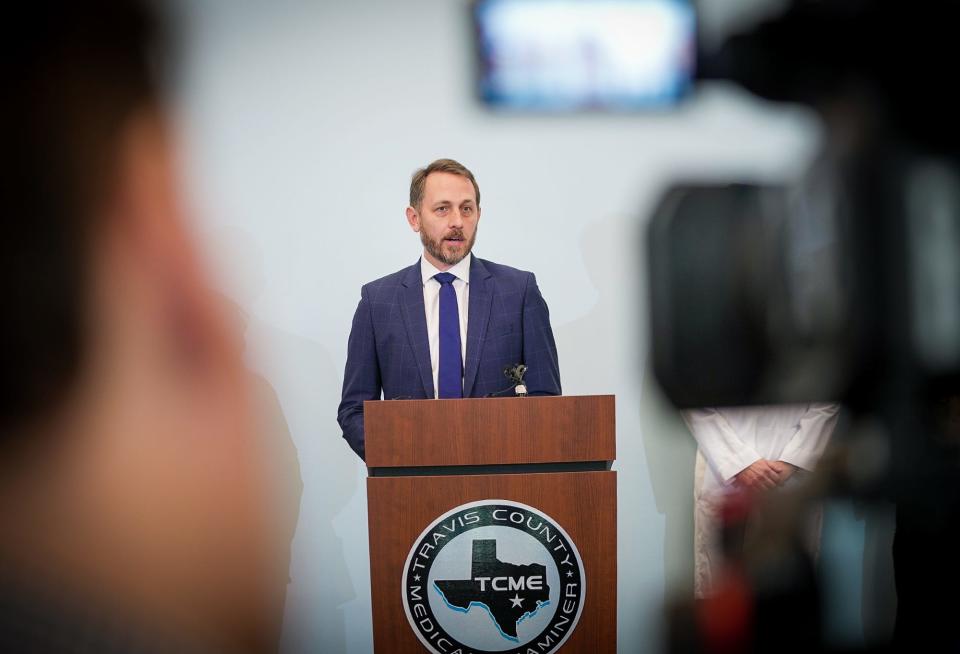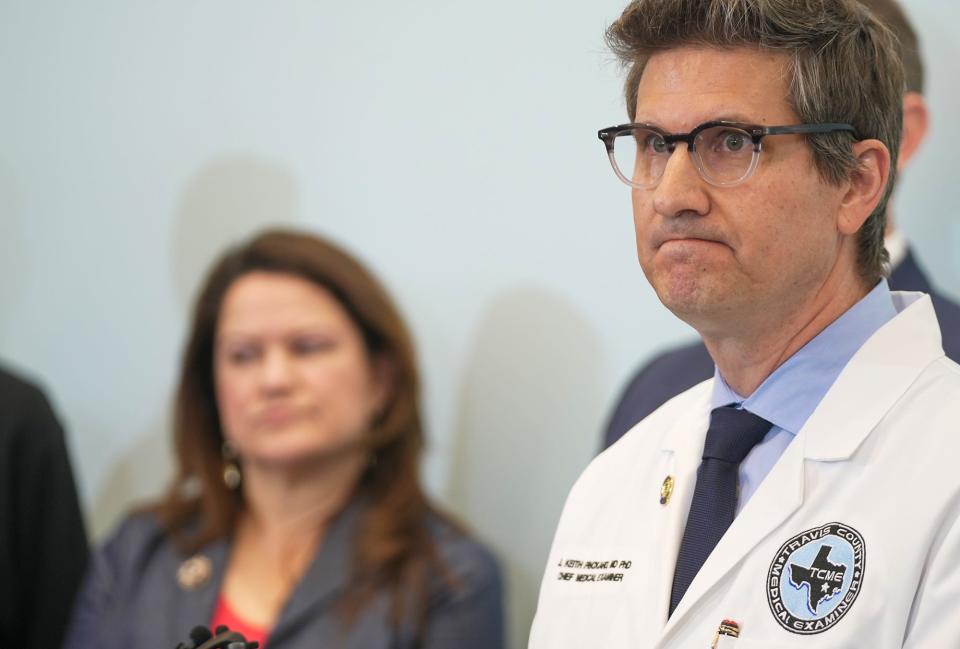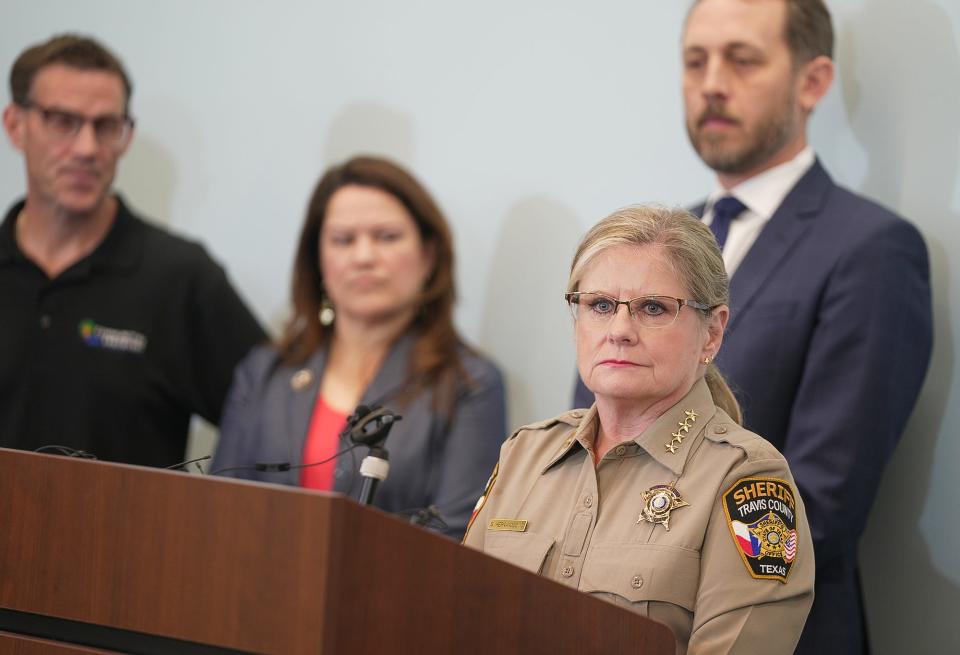Fentanyl-related overdoses grow tenfold from 2019; Travis County leaders work to find solutions
Fentanyl-related overdoses, for the second year in a row, are the leading cause of accidental deaths in Travis County. The deaths have grown tenfold since 2019, according to Travis County officials.
“Travis County is facing double the number of funerals, double the number of empty seats at the dinner table and double the number of families with more questions than answers,” Travis County Judge Andy Brown said. “This is and continues to be a significant threat to the public’s health and safety.”
Brown, in a news conference, said county leaders are working to understand how to better address the issue.

Fentanyl is a synthetic opiate with effects similar to heroin but much more powerful. It can be found as a pill, powder, patch, solid or liquid, and it can be lethal even in tiny doses, authorities have said.
Overall, the number of overdose deaths to such drugs as heroin, methamphetamine and cocaine, rose 35%, while fentanyl-related overdoses are up 108% in 2022 over 2021, according to data from the Travis County medical examiner's office.
The medical examiner’s office on Wednesday released its annual report for 2022. For the second year in a row, drug overdoses were the leading cause of accidental deaths.
Travis County, and communities across the Central Texas region, have been grappling with fentanyl-related overdose. In 2022, fentanyl-related deaths have claimed the lives of at least a dozen high school students and more than 70 people between ages 21 and 30 across the area.
More: Austin Public Health gets $2 million in federal money to fight fentanyl overdoses
Trends in the data pointing to this becoming a problem go back to at least 2019, according to advocates who specialize in drug addiction support and recovery services.
Data in 2019 showed there were 22 deaths from fentanyl overdose, and that number has increased yearly. In 2021, the county reported 118 accidental overdose deaths from fentanyl − a record, until 2022, when fentanyl deaths spiked to 245 people.

The data also show a disproportionate increase in overdoses among people of color and women. Among Black people, overdoses increased 460% from 2021 and 247% among Hispanics. Overdoses in women skyrocketed 192%.
Why is this happening? Local advocates and leaders say fentanyl is extremely cheap to produce and easier to smuggle than other drugs. The deadly drug is often found laced in counterfeit pills, made to resemble Percocet or oxycodone.
Travis County Sheriff Sally Hernandez said Wednesday there are several investigations open, but no arrests made yet in Travis County, as the department tries to trace the fentanyl back to dealers. At least three people − the latest a teenager from Kyle − have been charged in Hays County in connection with the sale of fentanyl-laced pills.
A joint federal, state and local investigation led to the January arrests of 13 people charged with fentanyl trafficking across Central Texas.
As opioid overdoses rise, Travis County prepares to declare public health crisis to tackle it
Addressing the problem
Last May, Travis County declared drug overdoses a public health crisis, dedicating $350,000 to harm reduction measures, including expanding free access to Narcan, the medication used to reverse the impact of opioid overdoses, and increasing education resources and awareness about the dangers of fentanyl.
Cate Graziani, executive director for the Texas Harm Reduction Alliance, said every overdose is preventable, and prevention goes beyond education and public messaging. She said local leaders need to invest more in harm reduction tools, like Narcan and fentanyl testing strips, and for housing.
“I’m devastated and angry by the numbers we are discussing today,” Graziani said. “We know how to do this, yet we are still seeing more than double in overdose deaths in our community. ... We can save lives if we have the resources and infrastructure to do so.”

Darrin Acker, executive director of Communities for Recovery, said organizations working with drug users and those in recovery need some consistency in funding.
"It's consistency and long-term engagement that makes a difference in the problems we are addressing," Acker said. "We have to have a plan and create outcomes we can measure so again we are here next year with the same issue and actually showing a reduction in deaths."
Brown said he will ask the Travis County Commissioners Court to dedicate $750,000 in the 2024 budget to create an overdose prevention fund with recommendations from the Texas Harm Reduction Alliance.
Funding will bolster and expand critical harm reduction infrastructure, such as Communities for Recovery and Texas Harm Reduction Alliance, and place fentanyl testing strips and Narcan in more places and for more people. The county fund can help for emergency purchases like more Narcan or other resources.
Graziani said 500 deaths were prevented through the organizations' program by having Narcan accessible.
Fentanyl overdose crisis: Here's what Texas lawmakers propose to address issue.
The city of Austin will also look at increasing access to Narcan and fund support programs in the upcoming budget cycle. Earlier this month, the City Council passed a resolution, authored by Council Member Mackenzie Kelly, to prioritize funding and resources to purchase Narcan as well as distribute the product and provide training to use it.
The approval of House Bill 362, legalizing fentanyl testing strip, would help, advocates said Wednesday. The bill is awaiting a Senate hearing.
“This bill is necessary. This change in the law is necessary,” Brown said. “It is not nearly enough alone to solve the problem, but it is necessary.”
But Graziani put the onus on local leaders.
"What would help is if the state would legalize fentanyl testing strips and other drug checking tools. We can't wait for the state to understand how to save lives of Travis County residents," she said. "We need public health strategies, housing options ... we need to shift the course into a harm reduction approach that will work."
This article originally appeared on Austin American-Statesman: Travis County medical examiner: Fentanyl related overdoses increase

